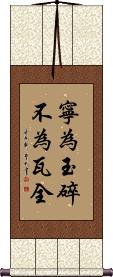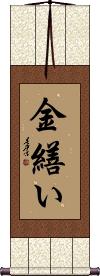Many custom options...
And formats...

Pottery in Chinese / Japanese...
Buy a Pottery calligraphy wall scroll here!
Personalize your custom “Pottery” project by clicking the button next to your favorite “Pottery” title below...
Death Before Dishonor
Better to be broken jade than unbroken pottery
寧為玉碎不為瓦全 is the long version of a Chinese proverb that means “rather be shattered piece of jade than an unbroken piece of pottery.”
A little more explanation:
Death is implied with the “broken” meaning. Jade is one of the most precious materials in Chinese history, and in this case, is compared with one's honor and self-worth. Pottery is just something you eat off of, it has no deep value, just as a person who has lost their honor, or had none to begin with.
Thus, this means “better to die with honor than to live in shame” or words to that effect.
寧為玉碎不為瓦全 is often translated in English as “Death Before Dishonor,” the famous military slogan.
I would also compare this to the English proverb, “Better to die on your feet than to live on your knees.”
This is an idiom. It therefore doesn’t directly say exactly what it means. If you think about the English idiom, "The grass is always greener," it does not directly say "jealousy" or "envy" but everyone knows that it is implied.
Kintsukuroi
Death Before Dishonor
Better to be broken jade than unbroken pottery
寧為玉碎 is the short version of a longer Chinese proverb which means “rather be shattered piece of jade than an unbroken piece of pottery.”
寧為玉碎 says the “rather be a broken piece of jade” part (the second half is implied - everyone in China knows this idiom).
A little more explanation:
Death is implied with the “broken” meaning. Jade is one of the most precious materials in Chinese history, and in this case, is compared with one's honor and self-worth. Pottery is just something you eat off of; it has no deep value, just as a person who has lost their honor or had none to begin with.
Thus, this means “better to die with honor than to live in shame” or words to that effect.
This is often translated in English as “Death Before Dishonor,” the famous military slogan.
I would also compare this to the English proverb, “Better to die on your feet than to live on your knees.”
These search terms might be related to Pottery:
Not the results for pottery that you were looking for?
Below are some entries from our dictionary that may match your pottery search...
| Characters If shown, 2nd row is Simp. Chinese |
Pronunciation Romanization |
Simple Dictionary Definition |
陶 see styles |
táo tao2 t`ao tao tou / to とう |
More info & calligraphy: Thao(See 陶器) pottery; earthenware; ceramics; porcelain; (surname, given name) Tou Pottery, kiln. |
金繕い see styles |
kintsukuroi; kinzukuroi きんつくろい; きんづくろい |
More info & calligraphy: Kintsukuroi |
匋 see styles |
táo tao2 t`ao tao |
pottery |
楽 see styles |
yuè yue4 yüeh raku らく |
Japanese variant of 樂|乐[yue4] (noun or adjectival noun) (1) comfort; ease; relief; (at) peace; relaxation; (noun or adjectival noun) (2) easy; simple; without trouble; without hardships; (noun or adjectival noun) (3) (economically) comfortable; (4) (abbreviation) (See 楽焼き) raku pottery; (5) {Buddh} (ant: 苦・2) sukha (happiness); (surname, female given name) Raku |
瓦 see styles |
wǎ wa3 wa kawara かわら |
roof tile; abbr. for 瓦特[wa3 te4] tile (e.g. roof); (surname, female given name) Kawara Tiles, pottery. |
甌 瓯 see styles |
ōu ou1 ou |
(pottery) bowl or drinking vessel |
甕 瓮 see styles |
wèng weng4 weng you / yo よう |
pottery container for water, wine etc (archaism) fired earthenware vessel used by the emperor to clean his hands; (surname) Yō kumbha, a pitcher, jar, pot. |
缶 see styles |
fǒu fou3 fou hotogi ほとぎ |
pottery (1) fat-bodied, small-mouthed earthenware jar for carrying water; (2) water vessel used for a baby's first bath; (surname) Hotogi |
上絵 see styles |
uwae うわえ |
printed figures (on cloth or pottery) |
作陶 see styles |
sakutou / sakuto さくとう |
(noun/participle) porcelain making; ceramics making; pottery making |
千筋 see styles |
sensuji せんすじ |
striped pattern (textiles, pottery) |
古陶 see styles |
kotou / koto ことう |
old pottery; antique porcelain; (given name) Kotou |
擊缶 击缶 see styles |
jí fǒu ji2 fou3 chi fou |
to beat time with a percussion instrument made of pottery |
有文 see styles |
aribumi ありぶみ |
(adj-no,n) (ant: 無文) patterned (e.g. clothes, pottery); figured; (male given name) Aribumi |
朱泥 see styles |
shudei / shude しゅでい |
unglazed reddish brown pottery (originally from China) |
楽焼 see styles |
rakuyaki らくやき |
raku ware; hand-moulded, lead glazed earthenware pottery fired at low temperatures, esp. used in tea ceremony (molded) |
櫛目 see styles |
kushime くしめ |
(sign of) combing; comb pattern (esp. pottery) |
火灯 see styles |
gatou / gato がとう katou / kato かとう |
pottery lantern (curved conical shape) |
火計 see styles |
hibakari ひばかり |
pottery fired in Japan but made with Korean ingredients by Korean potters brought to Japan after the Japanese invasions of Korea |
火頭 火头 see styles |
huǒ tóu huo3 tou2 huo t`ou huo tou kazu がとう |
pottery lantern (curved conical shape) A monastery cook. |
無文 无文 see styles |
wú wén wu2 wen2 wu wen mumon むもん |
(adj-no,n) (ant: 有文) unpatterned (e.g. clothes, pottery); unfigured; plain; (given name) Mumon no text |
無釉 see styles |
muyuu / muyu むゆう |
(can be adjective with の) unglazed (e.g. pottery) |
焼く see styles |
yaku やく |
(transitive verb) (1) to burn; (2) to roast; to broil; to grill; to bake; to toast; to barbecue; (3) to heat; to heat up; (4) to make (charcoal, pottery, bricks, etc.); to bake; to fire; to burn; (5) to tan (i.e. suntan); to burn; (6) to print (a photo); to burn (an optical disc); (7) to be jealous of; to be envious of; to envy |
焼成 see styles |
shousei / shose しょうせい |
(noun, transitive verb) baking at a high temperature; firing (pottery); calcination |
焼物 see styles |
yachimun; yachimun やちむん; ヤチムン |
(kana only) (rkb:) Okinawan pottery |
燒硬 烧硬 see styles |
shāo yìng shao1 ying4 shao ying |
to fire (pottery) |
燬く see styles |
yaku やく |
(out-dated kanji) (transitive verb) (1) to burn; (2) to roast; to broil; to grill; to bake; to toast; to barbecue; (3) to heat; to heat up; (4) to make (charcoal, pottery, bricks, etc.); to bake; to fire; to burn; (5) to tan (i.e. suntan); to burn; (6) to print (a photo); to burn (an optical disc); (7) to be jealous of; to be envious of; to envy |
瓦器 see styles |
wǎ qì wa3 qi4 wa ch`i wa chi gaki |
pottery pottery |
瓦灯 see styles |
gatou / gato がとう katou / kato かとう |
pottery lantern (curved conical shape) |
瓦燈 see styles |
gatou / gato がとう katou / kato かとう |
(out-dated kanji) pottery lantern (curved conical shape) |
Click here for more pottery results from our dictionary
The following table may be helpful for those studying Chinese or Japanese...
| Title | Characters | Romaji (Romanized Japanese) | Various forms of Romanized Chinese | |
| Death Before Dishonor | 寧為玉碎不為瓦全 宁为玉碎不为瓦全 | níng wéi yù suì bù wéi wǎ quán ning2 wei2 yu4 sui4 bu4 wei2 wa3 quan2 ning wei yu sui bu wei wa quan ningweiyusuibuweiwaquan | ning wei yü sui pu wei wa ch`üan ning wei yü sui pu wei wa chüan |
|
| Kintsukuroi | 金繕い | kintsukuroi | ||
| Death Before Dishonor | 寧為玉碎 宁为玉碎 | níng wéi yù suì ning2 wei2 yu4 sui4 ning wei yu sui ningweiyusui | ning wei yü sui ningweiyüsui |
|
| In some entries above you will see that characters have different versions above and below a line. In these cases, the characters above the line are Traditional Chinese, while the ones below are Simplified Chinese. | ||||
Successful Chinese Character and Japanese Kanji calligraphy searches within the last few hours...






